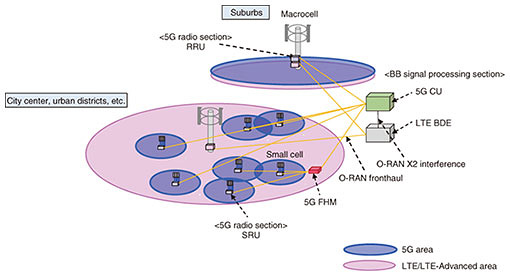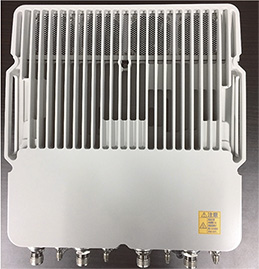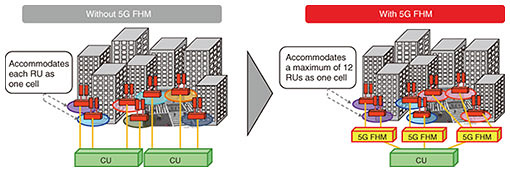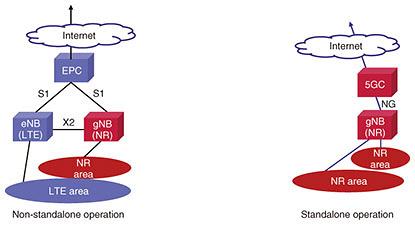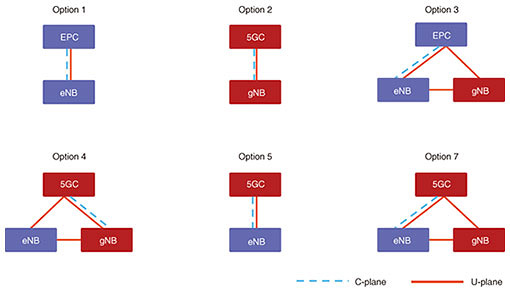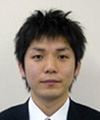 |
|||||||||||||||||||||||||||||||||||||||||||
|
|
|||||||||||||||||||||||||||||||||||||||||||
|
Feature Articles: NTT DOCOMO 5G Initiatives for Solving Social Problems and Achieving Social Transformation Vol. 18, No. 12, pp. 86–96, Dec. 2020. https://doi.org/10.53829/ntr202012fa13 5G NetworkAbstractNTT DOCOMO launched its fifth-generation mobile communications system (5G) commercial service in March 2020 achieving early provision and stable quality by making maximum use of functions and coverage provided by LTE (Long Term Evolution). This article describes the development of radio base-station equipment and core network equipment for providing the 5G commercial service. Keywords: 5G/NR, sub-6/mmW, non-standalone 1. IntroductionFeaturing high speed and large capacity, low latency, and massive connectivity, the fifth-generation mobile communications system (5G) is generating high expectations. In addition to providing richer content as in video services, it is anticipated that 5G will help find solutions to social problems that have so far been difficult to resolve and create new industries at the same time. After launching its 5G pre-commercial service in September 2019, NTT DOCOMO launched its 5G commercial service in March 2020. As of July 6, 2020, the number of 5G subscribers had already exceeded 170,000. The demand for 5G is expected to increase from here on, so the plan is to enhance the terminal lineup and expand 5G coverage in stages. In this article, we describe the development of radio base-station equipment and core network equipment to provide the 5G commercial service. 2. Overview of 5G frequency bandsIn 5G, there is a need for a network that can accommodate a variety of use cases and usage scenarios. From a technical perspective, this means adopting new radio technology, that is, 5G New Radio (NR), and supplementing existing frequency bands with those of even higher frequencies [1]. Three frequency bands have been allocated in Japan for 5G: the 3.7 GHz band (3.6–4.1 GHz), 4.5 GHz band (4.5–4.6 GHz), and the 28 GHz band (27.0–29.5 GHz, among which the 28.2–29.1 GHz interval is unallocated) (Table 1). The first two frequency bands are called the “sub-6” bands and the third one is called the millimeter wave (mmW) band.
The sub-6 bands each feature a 100 MHz bandwidth/operator within Japan’s 5G frequencies. Compared with Long Term Evolution (LTE), they enable wideband usage and can achieve the same coverage as the LTE 3.5 GHz band. The mmW band, meanwhile, is significantly different from the frequencies that have come to be used by LTE, and expectations are high for the spot-like rollout of services based on transmission speeds of several Gbit/s through ultra-wideband allocation. In general, however, the higher is the frequency the more difficult is wave propagation, so there will be a need to construct a heterogeneous network that combines the mmW band with existing LTE frequencies and the sub-6 bands. In addition, antenna downsizing is simple in the case of high-frequency bands, so the rollout of networks using massive multiple-input multiple-output (Massive MIMO) as advanced MIMO technology is anticipated. It must also be noted that existing systems are operating within Japan’s 5G frequency bands, so coexistence and segregation are important. In particular, since satellite system operators are also using the 3.7 GHz band, this band will be rolled out for 5G while making inter-system interference adjustments with those satellite systems. As a consequence, the 4.5 GHz band has been attracting attention as a frequency band that could play an effective role in achieving an early 5G rollout (Fig. 1). Additionally, looking at overseas trends, the use of the 3.7 GHz band and 28 GHz band has already begun in various countries, and from the perspective of future terminal support, roaming support, etc., these bands should be effective in rolling out high-speed and large-capacity services reflecting the unique features of 5G. The plan is to execute a commercial rollout that will make maximum use of the strengths of each of these frequency bands based on the features of those frequencies, coexistence with existing operators, and global trends.
As a result of approval received from the Ministry of Internal Affairs and Communications (MIC) for base-station installation plans [2], NTT DOCOMO has been allocated the frequency intervals 3.6–3.7 GHz and 4.5–4.6 GHz for a total of 200 MHz in the sub-6 bands and 27.4–27.8 GHz for a total of 400 MHz in the mmW band. In this way, NTT DOCOMO can provide a downlink peak rate of 3.4 Gbit/s in the sub-6 bands and of 4.1 Gbit/s in the mmW band in combination with the existing LTE system (Table 2).
The sub-6 bands and 28 GHz band have been allocated as time division duplex (TDD)*1 bands, but from the viewpoint of spectrum efficiency, the same downlink/uplink resource allocation (TDD Config)*2 must be used between neighboring cellular operators. In Japan, the TDD Config shown in Fig. 2 based on the TDD Config agreed upon at the 3rd Generation Partnership Project (3GPP) is being used for 5G operation taking data traffic and 5G service forecasts into account. In particular, to mitigate interference between the 3.7 GHz band and the neighboring LTE 3.5 GHz band, this TDD Config has been designed to use the same timing for downlink/uplink resources (Fig. 2). Additionally, in the 4.5 GHz band acquired solely by NTT DOCOMO, the plan is to establish an original TDD Config tailored to use cases with spectrum efficiency in mind.
3. 5G commercial development3.1 5G base-station equipment developmentThe 5G network configuration is shown in Fig. 3. With a view to 5G service development, NTT DOCOMO developed a central unit (CU) that consolidates the base band (BB) signal processing section supporting 5G, extended existing BB processing equipment known as high-density base-station digital processing equipment (BDE), and developed a 5G radio unit (RU) having signal transmit/receive functions. Furthermore, to have a single CU accommodate many RUs, NTT DOCOMO developed a 5G version of the fronthaul multiplexer (FHM) [4] deployed in LTE. Each of these three types of equipment is described below.
3.1.1 CU(1) Development concept With the aim of achieving a smooth rollout of 5G services, NTT DOCOMO developed a CU that enables area construction without having to replace existing equipment while minimizing the construction period and facility investment. This was accomplished by making maximum use of the existing high-density BDE that performs BB signal processing, replacing some of the cards of the high-density BDE, and upgrading the software to support 5G. (2) CU basic specifications An external view of this CU is shown in Photo 1. This equipment has the features described below.
As described above, this equipment enables 5G-supporting functions by replacing some of the cards of the existing high-density BDE. In addition, future software upgrades will load both software supporting conventional 3G/LTE/LTE-Advanced and software supporting 5G. This will enable the construction of a network supporting three generations of mobile communications from 3G to 5G with a single CU. The existing LTE-Advanced system employs advanced centralized radio access network (C-RAN)*3 architecture [4] proposed by NTT DOCOMO. This architecture is also supported in 5G with the connection between CU and RUs made via the fronthaul. Standardization of this fronthaul was promoted at the Open Radio Access Network (O-RAN) Alliance jointly established in February 2018 by five operators including NTT DOCOMO. Since the launch of 5G services, the fronthaul in the NTT DOCOMO network was made to conform to these O-RAN fronthaul specifications that enable interoperability between different vendors, and any CU and RU that conform to these specifications can be interconnected regardless of vendor. The specifications for interconnecting base-station equipment also conform to these O-RAN specifications, which means that a multi-vendor connection can be made between a CU supporting 5G and a high-density BDE supporting LTE-Advanced [5]. This enables NTT DOCOMO to deploy a CU regardless of the vendor of the existing high-density BDE and to quickly and flexibly roll out service areas where needed while making best use of existing assets. In addition, six or more fronthaul connections can be made per CU and the destination RU of each fronthaul connection can be selected. Since 5G supports wideband transmission beyond that of LTE-Advanced, the fronthaul transmission rate has been extended from the existing peak rate of 9.8 Gbit/s to a peak rate of 25 Gbit/s while achieving a CU/RU optical distance equivalent to that of the existing high-density BDE. 3.1.2 RU(1) Development concept To facilitate flexible area construction right from the launch of 5G services, NTT DOCOMO developed the low-power small radio unit (SRU) as the RU for small cells and developed, in particular, separate SRUs for each of the 3.7 GHz, 4.5 GHz, and 28 GHz frequency bands provided at the launch of the 5G pre-commercial service in September 2019. Furthermore, with an eye to early expansion of the 5G service area, NTT DOCOMO developed the regular power radio unit (RRU) as the RU for macrocells to enable the efficient creation of service areas in suburbs and elsewhere. A key 5G function is beamforming*4 that aims to reduce interference with other cells and thereby improve the user’s quality of experience. To support this function, NTT DOCOMO developed a unit that integrates the antenna and 5G radio section (antenna-integrated RU). It also developed a unit that separates the antenna and 5G radio section (antenna-separated RU) to enable an RU to be placed alongside existing 3G/LTE/LTE-Advanced radio equipment (RE) and facilitate flexible installation even for locations with limited space or other constraints. (2) SRU basic specifications As described above, NTT DOCOMO developed the SRU to enable flexible construction of 5G service areas. It developed, in particular, antenna-integrated SRUs to support each of the 3.7 GHz, 4.5 GHz, and 28 GHz frequency bands provided at the launch of the 5G pre-commercial service and antenna-separated SRUs to support each of the 3.7 GHz and 4.5 GHz frequency bands (Photo 2). These two types of SRUs have the following features.
The antenna-integrated RU is equipped with an antenna panel to implement the beamforming function. In the 3.7 GHz and 4.5 GHz bands, specifications call for a maximum of 8 beams, and in the 28 GHz band, for a maximum of 64 beams. An area may be formed with the number of transmit/receive beams tailored to the TDD Config used by NTT DOCOMO. In addition, the number of transmit/receive branches is 4 for the 3.7 GHz and 4.5 GHz bands and 2 for the 28 GHz band, and MIMO transmission/reception can be performed with a maximum of 4 layers for the former bands and a maximum of 2 layers for the latter band. The antenna-separated SRU is configured with only the radio as in conventional RE to save space and facilitate installation. With this type of SRU, the antenna may be installed at a different location. Moreover, compared to the antenna-integrated SRU operating in the same frequency band, the antenna-separated SRU reduces equipment volume to 6.5 L or less. The antenna-separated SRU does not support the beamforming function, but features four transmit/receive branches the same as the antenna-integrated SRU for the same frequency band. (3) RRU basic specifications The RRU was developed in conjunction with the 5G service rollout as high-power equipment compared with the SRU with a view to early expansion of the 5G service area (Photo 3). This type of equipment has the following features.
Compared with existing remote radio equipment for macrocells, the volume of RRU equipment tends to be larger to support 5G broadband, but in view of the latest electronic device trends, NTT DOCOMO took the lead in developing and deploying an antenna-separated RRU that could save space and reduce weight. Maximum transmission power is 36.3 W/100 MHz/branch*5 taking the radius of a macrocell area into account. The RRU features four transmit/receive branches and achieves the same number of MIMO transmission/reception layers as the antenna-separated SRU. NTT DOCOMO also plans to deploy an antenna-integrated RRU at a later date. The plan here is to construct 5G service areas in a flexible manner making best use of each of these models while taking installation location and other factors into account. 3.1.3 5G FHMThe 5G FHM is equipment having a multiplexing function for splitting and combining a maximum of 12 radio signals on the fronthaul. It was developed in conjunction with the 5G service rollout the same as RRU (Photo 4).
If no 5G FHM is being used, each RU is accommodated as one cell, but when using a 5G FHM, a maximum of 12 RUs can be accommodated as one cell in a CU. At the launch of 5G services, this meant that more RUs could be accommodated in a single CU when forming a service area in a location having low required radio capacity (Fig. 4). Additionally, since all RUs transmit and receive radio signals of the same cell, the 5G FHM can inhibit inter-RU interference and the occurrence of handover*6 control between RUs as in the conventional FHM. Furthermore, the 5G FHM supports all of the 5G frequency bands, that is, the 3.7 GHz, 4.5 GHz, and 28 GHz bands, which means that service areas can be constructed in a flexible manner applying each of these frequency bands as needed.
3.2 5G radio access network supportThis section presents an overview of the radio access network (RAN) configuration for achieving 5G services and LTE-NR Dual Connectivity, beam management technology, and NR high-speed support as RAN technologies. 3.2.1 RAN configurationAt the launch of its 5G commercial service, NTT DOCOMO provided services through non-standalone operation, a key feature of NR. Here, “non-standalone” means an operation format that provides services while using LTE/LTE-Advanced areas as an anchor*7 instead of providing 5G areas by NR alone. As shown in Fig. 5, evolved NodeB (eNB)*8 in NR non-standalone operation connects to a gNB*9 base station that provides NR using an X2*10 interface. In addition, eNB and gNB connect to the Evolved Packet Core (EPC)*11 using S1 interfaces. The use of LTE as an anchor in this way through non-standalone operation made for early commercialization of 5G by enabling the use of existing network infrastructure through shared use of LTE equipment while maintaining the same level of quality with respect to connectivity that had so far been provided. In addition, the connection between eNB and gNB conforms to the O-RAN X2 specifications spearheaded by NTT DOCOMO thereby enabling interoperability between different LTE and NR operators. In short, non-standalone operation made it possible to roll out 5G areas in a speedy and flexible manner against LTE areas that had already been established. In contrast, NR standalone operation, whose provision is scheduled for the future, will enable the provision of services through only gNB base stations. In this format, RAN will connect to the new core network, namely, the 5G core network (5GC), and gNB base stations will connect to each other using an Xn interface and a gNB will connect to 5GC using an NG interface.
3.2.2 LTE-NR Dual ConnectivityIn the non-standalone configuration described above that combines LTE/LTE-Advanced and NR to provide services, architecture that simultaneously transmits radio signals to the user equipment (UE) by both LTE and NR is called LTE-NR Dual Connectivity. In this architecture, the simultaneous transmission of both LTE and NR types of radio resource is specified as a split bearer*12, which achieves simultaneous transmission of a maximum of five LTE carrier*13 signals and NR and enables a speedy and flexible rollout of 5G commercial services. In LTE-NR Dual Connectivity operation in which an LTE base station acts as master node (MN), master cell group (MCG) split bearer would have to be performed on the LTE-base-station side as the bandwidth on the NR side becomes larger. It would therefore be necessary to augment the equipment on the LTE-base-station side whose capacity is limited compared with NR equipment thereby incurring equipment development and operation costs. Consequently, with the aim of minimizing the upgrading of LTE-base-station equipment and avoiding throughput limitations due to the capacity of that equipment, a secondary node (SN)-terminated split bearer and an SN-terminated MCG bearer were specified so that a branch point for user data in LTE-NR Dual Connectivity could be set up as NR equipment acting as a SN. The secondary cell group (SCG) split bearer is a method in which user data is transferred on both the MN carrier and SN carrier so that data can be transmitted to the user simultaneously from the SN and MN. This method achieves higher transmission speeds. In addition, the SN-terminated MCG bearer is a method that enables data to be transferred from the SN even if outside the NR area, which makes for more stable communications. 3.2.3 Beam management technologyNew beam management technology has been adopted in the NR system. As described above, the antenna-integrated RU has a configuration enabling the forming of multiple beams (Fig. 6).
Specifically, in Frequency Range 1 (FR1)*14, this technology uses digital beamforming that forms beams by applying phase rotation to the BB signal, and in Frequency Range 2 (FR2)*15, it uses analog beamforming that forms beams by controlling the phase in the radio frequency (RF) signal. The technology includes processing for selecting an optimal beam when beginning an NR connection and processing for switching beams due to a change in radio quality caused by UE movement or other factors. Using an optimal transmit/receive beam according to the position of the communicating UE ensures user coverage even in a high frequency band. At the same time, it can be expected that orienting the beam toward the position of the UE will have the effect of inhibiting radio-wave radiation in unnecessary directions and suppressing inter-cell interference. 3.2.4 NR high-speed supportIn 5G, even higher communications speeds can be achieved since Dual Connectivity allows NR to be simultaneously used with LTE/LTE-Advanced. Currently, in LTE/LTE-Advanced, NTT DOCOMO provides services with a downlink peak rate of 1.7 Gbit/s by combining five instances of a component carrier through carrier aggregation*16. However, in NTT DOCOMO 5G, Dual Connectivity of five LTE/LTE-Advanced component carriers and NR was achieved from the launch of 5G services enabling a downlink peak rate of 3.4 Gbit/s when using either the 3.7 GHz or 4.5 GHz NR band and a downlink peak rate of 4.1 Gbit/s when using the 28 GHz NR band. Furthermore, in uplink communications in the 28 GHz band, in addition to the simultaneous use of two component carriers for a total bandwidth of 200 MHz through carrier aggregation, a total data rate of 480 Mbit/s has been achieved through the implementation of 2 × 2 MIMO. The goal going forward is to increase data rates even further through the use of even wider frequency bands. In downlink communications, for example, this will be achieved through carrier aggregation between the 3.7 GHz and 4.5 GHz bands, and in uplink communications, through the carrier aggregation of four component carriers for a total bandwidth of 400 MHz in the 28 GHz band. 3.3 Development of core network equipmentMultiple migration architectures toward the provision of 5G have been proposed at 3GPP, an international standards organization. Figure 7 shows those architectures that have been specified at 3GPP. Option 1 is the architecture under which LTE has been provided. Options 2–5 and 7 are architectures for providing 5G, and each operator may decide which option(s) to adopt. As described above, NTT DOCOMO decided to launch 5G by adopting Option 3 architecture that connects to NR and provides 5G by extending EPC that had been in commercial operation for LTE. This approach made it possible to achieve early provision of the 5G commercial service while ensuring a stable level of quality provided by LTE/LTE-Advanced that was already in place. Many operators around the world adopted Option 3 at the time of their 5G launches.
NTT DOCOMO will continue its studies toward future means of migration including the introduction of 5GC, the new core network. 3.3.1 Option 3x architectureAs described above, user data is transferred by a SCG split bearer process to keep equipment development and operation costs down. In other words, control signals are exchanged between EPC and eNB while user data is exchanged between EPC and gNB. This architecture has been specified in the standard as Option 3x. The main feature of Option 3x architecture is that it enables NR to be accommodated by extending the S1 interface with eNB and the non-access stratum (NAS) interface with UE, which eases the impact on core network equipment and achieves both stable quality and early deployment. 3.3.2 High-throughput supportAt present, the 5G commercial service provides a maximum downlink throughput of 4.1 Gbit/s. NTT DOCOMO intends to continue its development efforts toward even higher data rates and larger capacities. However, EPC consists of various types of equipment of diverse levels of performance, and there are some types of equipment that cannot easily provide the throughput required by 5G. With this in mind, and considering that a serving gateway/packet data network gateway (S/P-GW) for performing data-transfer processing within EPC needs to be selected, NTT DOCOMO has developed a mechanism for selecting an S/P-GW that can provide 5G throughput. In more detail, the existing method for selecting an S/P-GW via a mobility management entity is to use tracking area and access point name as keys to query the domain name system (DNS) and to then select an S/P-GW from the record included in the response. To this method, NTT DOCOMO added a value (+nc-nr) indicating 5G capability to the service parameters (network capability) included in the DNS response. For the 5G user, using this value as a basis for selecting an S/P-GW that can provide 5G throughput achieves high-speed communications. 3.3.3 Low-latency networkNTT DOCOMO began the provision of its docomo Open Innovation Cloud simultaneously with the launch of its 5G commercial service. The docomo Open Innovation Cloud provides a form of multi-access edge computing. It enables end-to-end communications latency to be shortened by deploying computing resources normally included in the core network at locations near user terminals. It also provides NTT DOCOMO’s “Cloud DirectTM” service that shortens network transmission latency by optimizing the transmission path between the connected terminal and the cloud platform.
4. ConclusionThis article described the development of radio base-station equipment and core network equipment at NTT DOCOMO to provide a 5G commercial service. Going forward, NTT DOCOMO will pursue co-creation opportunities through 5G with a variety of partners to contribute to the creation of a prosperous society while continuing to develop groundbreaking and advanced technologies. This article is the reproduction of the special article published in NTT DOCOMO Technical Journal (Vol. 22, No. 2, Oct. 2020). References
Trademark notesAll company names or names of products, software, and services appearing in this article are trademarks or registered trademarks of their respective owners. |
|||||||||||||||||||||||||||||||||||||||||||













